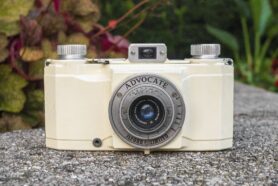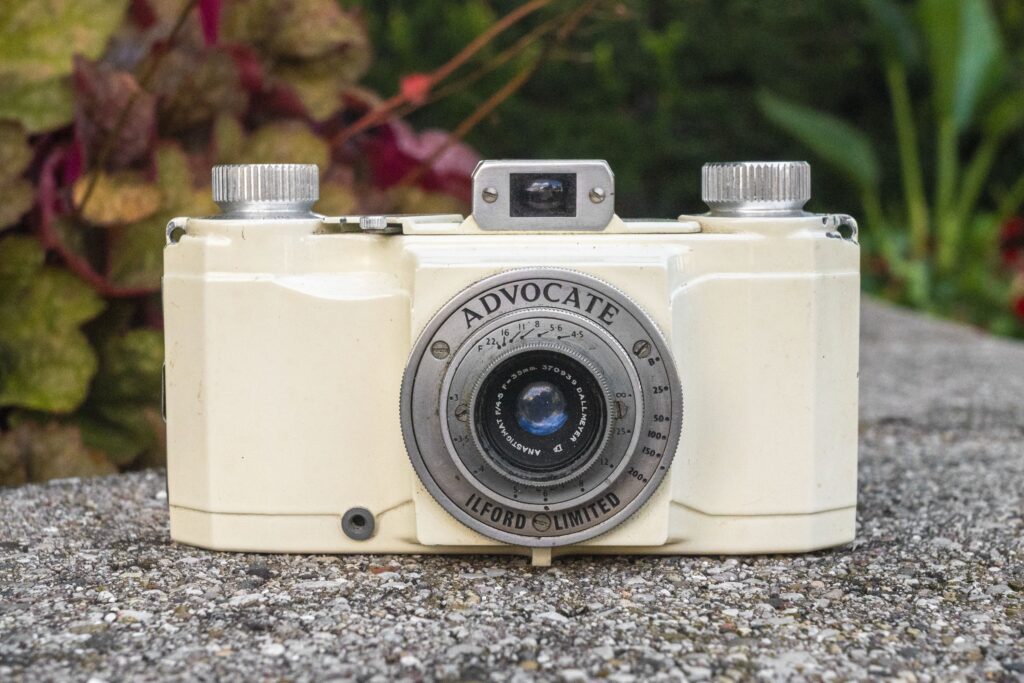This is an Ilford Advocate, a 35mm scale focus camera, made by Kennedy Instruments, Ltd. for their parent company, Ilford, Ltd in London, England between the years 1949 and 1957. The Advocate was one of the most popular cameras to feature the Ilford name, a company most commonly associated with a long running line of photographic film. The Advocate is a simple, yet attractive camera which is most notably recognized by its cream enamel covered body. It features a 35mm Dallmeyer lens which made it one of the first semi-wide angle 35mm cameras of the 20th century. Along with a simple five speed shutter, the Dallmeyer lens offers great depth of field, allowing it to be used outdoors with the benefit of great depth of field. Despite being a pretty popular camera in its day, examples of this camera are difficult to find today, making them quite valuable.
Film Type: 135 (35mm)
Lens: 35mm f/4.5 Dallmeyer Anastigmat coated 3-elements
Focus: 3 feet to Infinity
Viewfinder: Scale Focus Optical Finder
Shutter: Ilford Leaf
Speeds: B, 1/25 – 1/200 seconds
Exposure Meter: None
Battery: None
Flash Mount: None
Weight: 510 grams
Manual: https://www.cameramanuals.org/pdf_files/ilford_advocate.pdf
Ilford, Kodak, Ferrania, Fuji, Agfa, and Konica are all brands who were known as makers of film products and cameras. Of those six companies, Ilford and Kodak are the most similar in that their business was overwhelmingly for their film production and any cameras produced by or for the companies, each model was made for the express purpose of generating more customer for their film. What better way to build a captive customer base, then by selling the very devices need to consume your primary product?
In the case of Ilford, only a very small number of models exist with the company’s name, and all of them were built by third parties. This is in stark contrast to other film and camera companies who at one time built their own models.
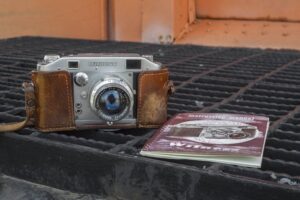
For Ilford’s first two attempts at making cameras, they turned to outside sources for construction of their new cameras. For the Ilford Advocate, the partner company was called Kennedy Instruments, Ltd. in London, England. Although the second camera revealed with the Ilford name, the Advocate was the first to be released, beating the far more ambitious Ilford Witness to market by a full four years. Where the Witness was a full featured interchangeable lens rangefinder which was supposed to go head to head with the German Leica, the Advocate was a simpler scale focus camera with a five speed leaf shutter and a semi wide angle 35mm lens.
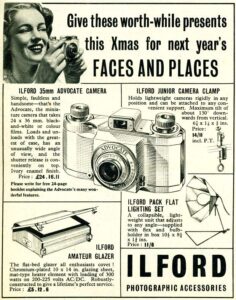
As you might expect, the simpler and less expensive camera which reached market quicker, was far more successful. The Ilford Witness was in development for so long, that by the time it was released, its features were behind the times, and with an extremely high price, sold poorly. With less than 350 thought to have ever been made, the Witness is forgotten by all but the most dedicated collectors.
The Advocate on the other hand sold well and was produced for about eight years. In a 1953 ad, the Advocate was shown with a retail price of £24.16s.11d which is nearly one-fifth the price of the Ilford Witness which also sold in 1953 for a whopping £121.16s.8d. For a price that was five times more, the typical British amateur photographer did not feel like they were getting five times the camera, and avoided the Witness.
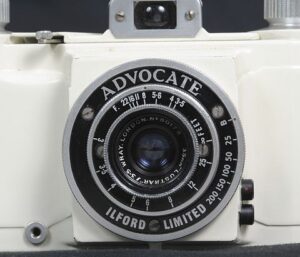
During its production, two versions of the Ilford Advocate were made. The model being reviewed here is a Series 1 which started production in 1949, but in 1952, an improved Series 2 model appeared with two key changes. The first was a switch to a faster f/3.5 Dallmeyer Anastigmat lens, but also the inclusion of two black flash sync ports on the side of the shutter. In addition to this, two minor changes were also made, which were the numbers on the focus scale became larger, making them easier to read, and the film door hinge and lock was improved.
During production of the Series 2 cameras, supply of the Dallmeyer lens became scarce, so a small number of Advocates were fitted with a Wray London Lustrar 35mm f/3.5 lens. The Wray equipped cameras also featured a distinct black shutter plate, making them very easy to spot by collectors. A study based on serial numbers of the Wray equipped Advocates suggest that less than 400 of these were made.
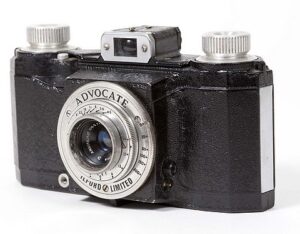
In addition to the Series 1 and 2 cameras, a small number of black painted Advocates were made, some with a crinkle paint finish and at least one with a smooth finish. Although it wouldn’t be difficult to repaint a white camera with black enamel, these black Advocates appear to be originals created as “employee specials” by workers at Kennedy Instruments, where the cameras were built.
By most accounts, the Ilford Advocate appears to have been a successful camera, at least in the United Kingdom. Whether these cameras were exported to other countries is uncertain, but if the point of making an Ilford camera was to sell more Ilford film, I have to imagine it did pretty well. According to a rough estimate given on photomemorabilia.co.uk, about 10,000 Ilford Advocates were produced with an even split between Series 1 and 2 models.
What Color is the Ilford Advocate? A majority of references to the Ilford Advocate refer to it as having a white enamel finish when in reality, the color isn’t pure white, rather it is more of an off-white cream color. When looking at images of these cameras online, ambient lighting and the white balance of whatever camera is making the photo can also affect the look of the camera, making some look more like a darker almond or ivory color. In addition to color balance, age seems to have taken its toll on the finish, causing some models to yellow more than others, further altering the original color.
The truth is, slight variations in the color of the camera date back to when these cameras were new, as the enamel used changed throughout the production run of the camera. If you are fortunate enough to come across more than one of these cameras, if they don’t look exactly the same, the difference could be in age, but could also have just been how they were since they day they were made.
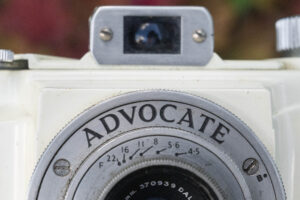
I have exactly two white cameras in my entire collection, the Ilford Advocate and the Revere Eye-Matic EE 127. Why Ilford chose to make an all white camera as opposed to black or chrome plated like pretty much everyone else is anyone’s guess, but whatever reason they had, it certainly gives the Advocate a distinct look. This is one of those cameras which can easily be spotted on a shelf in a low resolution JPG image online as it looks nothing like the Revere.
The camera is entirely die-cast metal covered in a cream colored enamel which has a nice shine, but has the side effect of being a bit slippery. One benefit from natural or synthetic body coverings is they enhance your grip on the camera. While I never felt like the camera was going to slip out of my hands like a wet bar of soap, that it has such little grip should be taken into consideration if you plan on shooting the camera in wet situations.
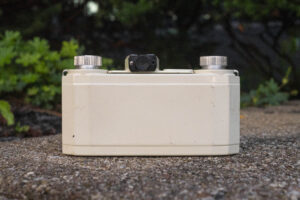
The enamel covered die cast metal body gives the camera a bit of heft, but its finish is prone to chipping. This particular model has a good amount of paint loss near the strap lugs and near the corners. Whenever I hold the Advocate, I am reminded of mid-20th century children’s toys which were often made of the same kinds of enamel covered die cast metal. I won’t go as far as to say the Advocate feels like a children’s toy, rather, I get that impression much more than I would with a Leica or other German equivalent camera.
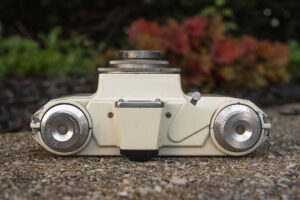
The ergonomics of the camera are pretty good, with symmetrical knobs for film advance and rewind on the top plate and a shutter release lever, which slides from left to right on the front edge of the camera. The Advocate lacks a traditional rewind release button or switch. When you’ve reached the end of a roll of film, rewinding the film is done by pressing in and holding the wind knob to disengage the film transport, while rotating the rewind knob until the film has completely rewound. The viewfinder is tiny and cramped, but otherwise works consistently with other 1940s designed 35mm cameras. A cable threaded socket is present on the front face of the camera, below and to the left of the shutter.
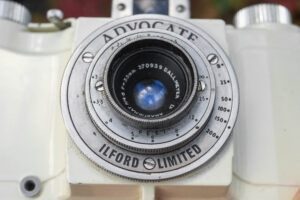
At first glance, the Advocate looks like it might have a collapsible lens, but it doesn’t. This results in the shutter, aperture, and focus rings being all tightly squished together in a small place. Changing any of these three settings requires you to lower the camera from your eye and look closely for a tiny dot on each of the three rings to let you know which settings you have selected. This isn’t difficult to do, but it does slow you down while out shooting. Thankfully, at least for focus, the wide depth of field offered by the 35mm Dallmeyer lens allows you to shoot most outdoor scenes without having to change focus often. Shoot a whole roll in consistent lighting and of images 10-50 feet away and the Ilford Advocate becomes a point and shoot camera.
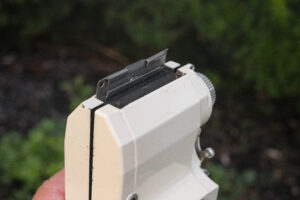
Perhaps the worst part about the camera’s design is in how the film compartment opens. A simple metal bracket on the side of the camera holds the film door shut. Two holes in the bracket wrap around two small posts, creating just enough friction to keep the door from opening, but it really doesn’t take much force for it to accidentally open. I suspect that a large number of rolls have been ruined in Ilford Advocates due to the door unintentionally being opened. According to my research, improvements to the door latch were made in the Series 2 Advocates, but as I did not have access to one for this review, I cannot confirm what was changed.
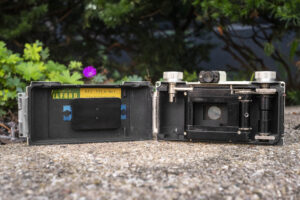
A strange feature of the film compartment is that the entire rewind knob and its forked shaft swings out of the camera for loading and unloading a cassette. This works surprisingly well and is a feature that I wish more 35mm cameras had. Beyond this, loading film into the camera is much like most other 35mm cameras of the era.
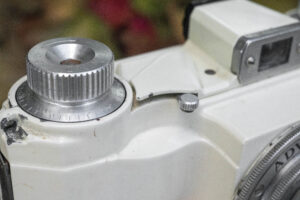
With film in the camera, using the Ilford Advocate is pretty straightforward. Although the camera wasn’t perfect, I quite liked the feel of it in my hands. Most of the controls are located in locations where my hands and fingers naturally expected them to be. The viewfinder was small, but it wasn’t prohibitively small.
Without much else to research on the camera, I decided to take it out, and what better film to shoot an Ilford camera than with some Ilford film. Currently, the only 35mm Ilford film I have in stock was a bulk roll of expired Ilford XP2 400. This is a chromogenic black and white film which means it is designed to be developed in C41 color film chemicals, but can also be developed like regular black and white film too. These types of films became popular in the 1980s as many photo processors started using minilabs which only did C41. With chromogenic black and white, photographers could shoot a true black and white film and have it developed alongside color films. For me however, I developed it using HC-110b as I do for nearly all my black and white film.
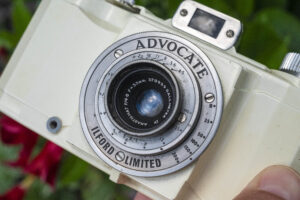
The images I got from the Ilford XP2 400 were quite nice. I was impressed at how little grain was visible despite being an ASA 400 film. Contrast was a bit low, which I’ve read is a side effect of developing C41 black and white film in HC-110, but it wasn’t anything that detracted from the overall image.
The images weren’t as razor sharp as you might get from a more advanced 6-element lens, but what really impressed me was the 35mm focal range of the Dallmeyer lens. While looking at the distinct and attractive cream enameled body of the Advocate, it is easy to overlook that this was one of the very first fixed lens 35mm cameras to have a semi-wide angle 35mm lens. Impressively, vignetting and edge softness was kept to a minimum. Looking at the gallery above, the corners aren’t dramatically darker than the center, even on images showing the sky.
Having such a wide lens also has the benefit of giving enhanced depth of field. While I found no official depth of field charts for the Ilford Advocate, a simple internet search for a DOF calculator suggests that a 35mm lens stopped down to f/11 with the lens set to 10 feet, will allow for everything from 6 to 33 feet to be in focus. Stop it down farther to f/16 and you can almost reach infinity, making the Advocate like a focus free camera. Some might suggest that a camera like this might have benefitted from a rangefinder, and I disagree. Armed with the 35mm Dallmeyer not only kept the price of the camera down, but simplified the shooting process, allowing me to get through my entire test roll without a single out of focus image.
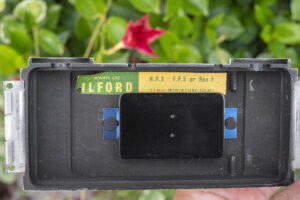
The Advocate is a pretty straight forward camera to use. The only oddities are in the door latch for the film door and the swiveling take up spool in the film compartment, The shutter release design is unusual too, but actually works really well. The location of the little handle falls naturally to where my index finger was while holding the camera, however I found the distance the lever needs to travel to fire the shutter a bit long. I did have to read the manual to figure out how to rewind the film, but once I knew, it wasn’t difficult.
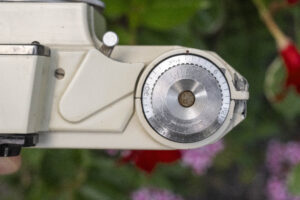
Being one of the very few people who has shot both an Ilford Witness and Advocate within 12 months of each other, I can see how the Advocate was a more successful camera. Despite the “near Leica” specifications of the Witness, the Advocate is a much simpler and easier to use camera. Combine that with a significantly lower retail price, it is very easy to see why this camera was so much more successful than its more advanced sibling.
I quite liked my time with the Advocate. While it is pretty to look at, I did not love the slick enamel finish and would have preferred a more normal leather or leatherette covering. I also found the film advance on this example to be a little gritty, but that certainly has more to do with its age probably than design. In addition, I did not love how close together all three rings for shutter speed, aperture, and focus were, but I guess that’s the compromise of a small, wide angle lens.
The Ilford Advocate may not be as unobtanium as the Witness is today, but it is still not a cheap camera to collect, but if you happen to be in search for something different, yet is a fun and capable shooter, you could do much worse than an Ilford Advocate.
Related Posts You Might Enjoy
External Links
http://camera-wiki.org/wiki/Ilford_Advocate
https://www.photomemorabilia.co.uk/Ilford/Advocate.html
https://www.dancuny.com/camera-collecting-blog/2024/9/4/ilford-advocate-camera
https://www.licm.org.uk/livingImage/Ilford_Advocate.html
https://www.photo.net/forums/topic/532112-the-ilford-advocate-gets-a-run-out/


